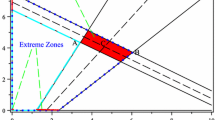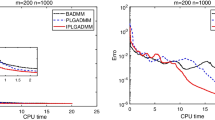Abstract
Since the beginning of the development of interior-point methods, there exists a puzzling gap between the results in theory and the observations in numerical experience, i.e., algorithms with good polynomial bounds are not computationally efficient and algorithms demonstrated efficiency in computation do not have a good or any polynomial bound. Todd raised a question in 2002: “Can we find a theoretically and practically efficient way to reoptimize?” This paper is an effort to close the gap. We propose two arc-search infeasible interior-point algorithms with infeasible central path neighborhood wider than all existing infeasible interior-point algorithms that are proved to be convergent. We show that the first algorithm is polynomial and its simplified version has a complexity bound equal to the best known complexity bound for all (feasible or infeasible) interior-point algorithms. We demonstrate the computational efficiency of the proposed algorithms by testing all Netlib linear programming problems in standard form and comparing the numerical results to those obtained by Mehrotra’s predictor-corrector algorithm and a recently developed more efficient arc-search algorithm (the convergence of these two algorithms is unknown). We conclude that the newly proposed algorithms are not only polynomial but also computationally competitive compared to both Mehrotra’s predictor-corrector algorithm and the efficient arc-search algorithm.
Similar content being viewed by others
References
Wright, S.: Primal-Dual Interior-Point Methods. SIAM, Philadelphia (1997)
Mehrotra, S.: On the implementation of a primal-dual interior point method. SIAM J. Optim. 2, 575–601 (1992)
Lustig, I., Marsten, R., Shannon, D.: Computational experience with a primal-dual interior-point method for linear programming. Linear Algebra Appl. 152, 191–222 (1991)
Lustig, I., Marsten, R., Shannon, D.: On implementing Mehrotra’s predictor-corrector interior-point method for linear programming. SIAM J. Optim. 2, 432–449 (1992)
Monteiro, R., Adler, I., Resende, M.: A polynomial-time primal-dual affine scaling algorithm for linear and convex quadratic programming and its power series extension. Math. Oper. Res. 15, 191–214 (1990)
Kojima, M., Mizuno, S., Yoshise, A.: A polynomial-time algorithm for a class of linear complementarity problem. Math. Program. 44, 1–26 (1989)
Kojima, M., Mizuno, S., Yoshise, A.: A primal-dual interior-point algorithm for linear programming. In: Megiddo, N. (ed.) Progress in Mathematical Programming: Interior-point and Related Methods. Springer-Verlag, New York (1989)
Cartis, C.: Some disadvantages of a Mehrotra-type primal-dual corrector interior-point algorithm for linear programming. Appl. Numer. Math. 59, 1110–1119 (2009)
Klee, V., Minty, G.: How good is the simplex algorithm? In: Shisha, O. (ed.) Inequalities, vol. III, pp 159–175, Academic Press (1972)
Khachiyan, L.: A polynomial algorithm in linear programming. Doklady Akademiia Nauk SSSR 224, 1093–1096 (1979)
Karmarkar, N.: A new polynomial-time algorithm for linear programming. Combinatorica 4, 375–395 (1984)
Todd, M.J.: The many facets of linear programming. Math. Progr. Ser B 91, 417–436 (2002)
Yang, Y.: A polynomial arc-search interior-point algorithm for linear programming. J. Optim. Theory Appl. 158(3), 859–873 (2013)
Yang, Y.: A polynomial arc-search interior-point algorithm for convex quadratic programming. Eur. J. Oper. Res. 215, 25–38 (2011)
Cartis, C., Gould, N.I.M.: Finding a point in the relative interior of a polyhedron. Technical Report NA-07/01, Computing Laboratory Oxford University (2007)
Yang, Y.: CurveLP-a MATLAB implementation of an infeasible interior-point algorithm for linear programming. Numer. Algorithms 74(4), 967–996 (2017)
Zhang, Y.: On the convergence of a class of infeasible interior-point methods for the horizontal linear complementarity problem. SIAM J. Optim. 4, 208–227 (1994)
Mizuno, M.: Polynomiality of infeasible interior-point algorithms for linear programming, vol. 67, pp. 109–119 (1994)
Miao, J.: Two infeasible interior-point predict-corrector algorithms for linear programming. SIAM J. Optim. 6(3), 587–599 (1996)
Yang, Y., Yamashita, M.: An arc-search O(nL) infeasible-interior-point algorithm for linear programming. Optim. Lett. https://doi.org/10.1007/s11590-017-1142-9
Kojima, M.: Basic lemmas in polynomial-time infeasible interior-point methods for linear programming. Ann. Oper. Res. 62, 1–28 (1996)
Andersen, E.D.: Finding all linearly dependent rows in large-scale linear programming. Optim. Methods Softw. 6, 219–227 (1995)
Yang, Y.: Arc-search path-following interior-point algorithms for linear programming, Optimization Online. http://www.optimization-online.org/DB_HTML/2009/08/2375.html (2009)
Yang, Y.: An Efficient Polynomial Interior-Point Algorithm for Linear Programming, arXiv:1304.3677 [math.OC] (2013)
Kojima, M., Megiddo, N., Mizuno, S.: A primal-dual infeasible interior-point algorithm for linear programming. Math. Program. Series A 61, 261–280 (1993)
Czyzyk, J., Mehrotra, S., Wagner, M., Wright, S.J.: PCx User Guide (version 1.1). Technical Report OTC 96/01 Optimization Technology Center (1997)
Zhang, Y.: Solving large-scale linear programs by interior-point methods under the Matlab environment. Technical Report TR96-01, Department of Mathematics and Statistics University of Maryland (1996)
Ng, E., Peyton, B.W.: Block sparse Cholesky algorithm on advanced uniprocessor computers. SIAM J. Sci. Comput. 14, 1034–1056 (1993)
Liu, J.W.: Modification of the minimum degree algorithm by multiple elimination. ACM Trans. Math. Softw. 11, 141–153 (1985)
Guler, O., den Hertog, D., Roos, C., Terlaky, T., Tsuchiya, T.: Degeneracy in interior-point methods for linear programming: A survey. Ann. Oper. Res. 46, 107–138 (1993)
Gill, P.E., Murray, W., Saunders, M.A., Tomlin, J.A., Wright, M.H.: On projected Newton barrier methods for linear programming and an equivalence of Karmarkar’s projective method. Math. Program. 36, 183–209 (1986)
Ekefer, J.: Sequential minimax search for a maximum. Proc. Amer. Math. Soc. 4, 502–506 (1953)
Luenberger, D.: Linear and Nonlinear Programming, 2nd edn. Addison-Wesley Publishing Company, Menlo Park (1984)
Tits, A.L., Yang, Y.: Globally convergent algorithms for robust pole assignment by state feedback. IEEE Trans. Autom. Control 41, 1432–1452 (1996)
Dolan, E.D., More, J.J.: Benchmarking optimization software with performance profiles. Math. Program. 91, 201–213 (2002)
Acknowledgments
The author would like to thank Dr. Chris Hoxie, in the Office of Research at US NRC, for providing a computational environment for this research.
Author information
Authors and Affiliations
Corresponding author
Rights and permissions
About this article
Cite this article
Yang, Y. Two computationally efficient polynomial-iteration infeasible interior-point algorithms for linear programming. Numer Algor 79, 957–992 (2018). https://doi.org/10.1007/s11075-018-0469-3
Received:
Accepted:
Published:
Issue Date:
DOI: https://doi.org/10.1007/s11075-018-0469-3




